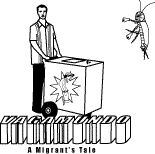
Vagamundo is a mobile public art project designed for on the street interaction to create temporary public commons. Through a mobile cart resembling an ice cream cart pedestrians are invited to play a video game that reflects the plight of undocumented migrants in New York.
In the United States, there are currently over eight million illegal immigrants, including more than three million from Mexico. The majority of these immigrants compose a near slave labor population contributing to the U.S. economy. Meanwhile the U.S. Government has spent over twelve billion dollars since 1992 to deter immigration along the southern border by implementing operations Gatekeeper in California, Safeguard in Arizona and Rio Grande in Texas.
Since 9/11, the Bush administration has added 100 million dollars to border patrol, increasing the annual tab to 2.5 billion dollars. However the number of people crossing the border has not decreased, though the number of mortalities along the trek across the border has increased, perhaps this is the point.
People desperately seeking to escape poverty will not be deterred by border patrol, they will merely be forced to risk much more dangerous and isolated paths through canals, deserts and mountains. In June of 2002, 70 people died crossing the border according to Mexican records and 62 according to U.S. records.
The fortunate people that successfully make it through the border and into a community, face the daunting task of entering into the U.S. economy while struggling against such factors as being undocumented, not speaking English, and racism and discrimination. Many who can not find a means into the mainstream economy, must create an alternate means of sustenance.
On a summer's day walk in East Williamsburg and other parts of Brooklyn, you will encounter street food vendors who have constructed their own carts and sell home cooked foods such as tamales. These people represent an alternate economy. In all major cities today you are likely to find paleteros, vendors of ice cream bars, a relatively new immigrant based business in many cities. A business far more common in Latin American developing countries, but now increasing in the United States, as the Third World tactics of survival grow within the U.S.
The project is informed by interviews that I conducted with new immigrants from Latin America residing in Manhattan and Brooklyn as well as years of working as a busboy in San Francisco. The game, that is a computer, monitor and joystick are placed within a hand built cart that sits on two back tires and a front caster. The use of the hand built ice cream cart establishes a concrete association with the thousands of paleteros found in major U.S. cities pushing their carts and selling various flavors of crushed ice for a dollar through hot summer days.
The game is composed of three levels each level represents a move up in the social scale and assimilation to the United States. The player controls the main character of the game, Cantinflas, the famous Mexican comedian of the Golden Age of Mexican Cinema; an iconic figure not unlike Charlie Chaplin. In each level, Cantinflas must overcome an obstacle to continue ahead:
Level 1: El Borracho, represents a ìCulture of Poverty" as an outcome of cultural traits such as bad work habits, heavy drinking, and violence. The player must avoid the flying liquor bottles to earn a job.
Level 2: The Green Grocer Bagger represents a "Culture of Assimilation." In the second level, the player acquires a job at a corner grocery as a bagger and florist, jobs favored by new immigrants, because it allows them to begin learning English. However in the game, the player must fight and beat the stereotype monster, a giant cockroach.
Level 3: The Head Waiter represents a "Culture of Prosperity." The player has learned English and is now a waiter at an upscale restaurant in the Upper East Side. Cantinflas must keep the guests happy and earn $200 in tips to beat the game.
Extra Level: Once the player has won the game, s/he is offered the choice to discriminate against new immigrants or two help new immigrants. If the player selects to discriminate, s/he is awarded an extra level as border patrol, where one may fire at illegal immigrants. If the player selects to help, s/he is awarded a list of informative books and contact information to nonprofit organizations dedicated to helping new immigrants.
Ideally, the project achieves two goals. First to present an interesting tableau that interrupts the given codes of public space as an unsuspecting pedestrian discovers a free videogame in an ice cream cart. And second, Vagamundo places the player in the role of a new, undocumented immigrant to New York City, an experience that may cause one to consider what life is like for others. The "others" that the project concerns itself with is an impoverished immigrant subculture that goes highly unnoticed by main stream media; a subculture that only receives news coverage in events of disaster, such as the death of seventeen individuals due to asphyxiation in the back of a truck, after paying $2000 each to be taken across the border. Hence the project doesn't seek to create a positive image of how far Hispanics have come in the United States, that is the cosmetic image that main stream media does choose to represent. Rather, I seek to put the viewer/player in a game that will have her/him reflect upon the intense hardships of undocumented immigrants during the journey across the border as well as part of our labor force once here in the United States.
Ricardo Miranda Zuniga
